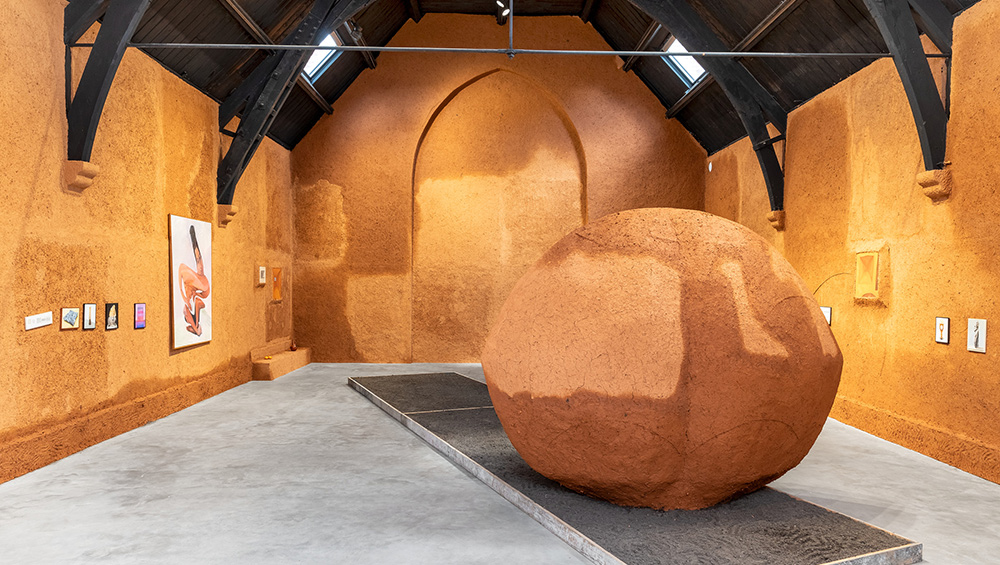
Gabriel Chaile in collaboration with Laura Ojeda Bär, Usos y costumbres, installation view, Studio Voltaire, 2023. Images courtesy of the artists and Studio Voltaire. Photo: Sarah Rainer.
by VERONICA SIMPSON
There was huge warmth and character in The Milk of Dreams, the installation by Gabriel Chaile (b1985, Tucumán, Argentina) for the 2022 Venice Art Biennale, comprising five “sculpture ovens” that each represented a member of his family. It was no stretch of the imagination to feel the affection, admiration and respect that inspired the central figure in this grouping of large terracotta vessels: his maternal grandmother, Rosario Liendro, after whom the piece was named. Their ageless forms, plastered with humble adobe – an ancient building material of mud and straw used to construct homes across Africa, India and South and Central America - clearly articulated “an expression of the body’s capacity for communalism, giving and care”.
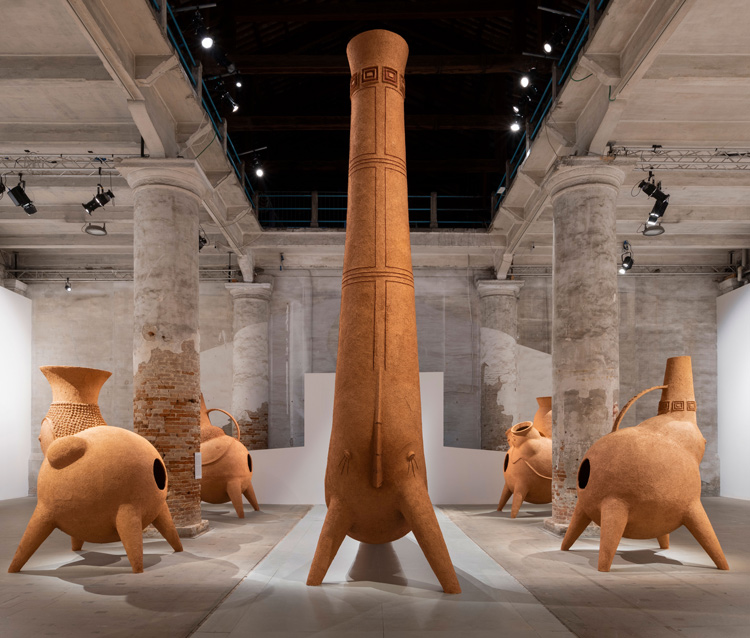
Gabriel Chaile, The Milk of Dreams. installation view, 59th Venice Biennale, 2022. Photo: Andrea Rossetti. Courtesy of BARRO Arte Contemporáneo, Buenos Aires and Gabriel Chaile, Lisbon and ChertLüdde, Berlin.
It was with high anticipation I went to see his installation Usos y Costumbres at Studio Voltaire in Clapham, south London, following his five-week residency in this artist-run space. Studio Voltaire is one of the UK’s leading not-for-profit arts organisations, with a strong history of supporting artists at pivotal points in their careers, through residency and exhibition opportunities. It now houses 61 studios in a refurbished factory building to their rear of its exhibition space. The latter space, a Victorian building that was formerly a Methodist chapel, has been transformed from a humble place of worship into a welcoming ensemble of buildings comprising gallery, cafe, courtyard and shop. The refurbishment amplifies its clear ethos of creativity, community and – with the ancient chapel – sacred and secular ritual, which resonates with the central themes of Chaile’s work. As artist-in-residence, he was given free rein to respond to this former chapel and the spirit of the whole Voltaire enterprise and amplify or dialogue with its character. I was keen to see the result.
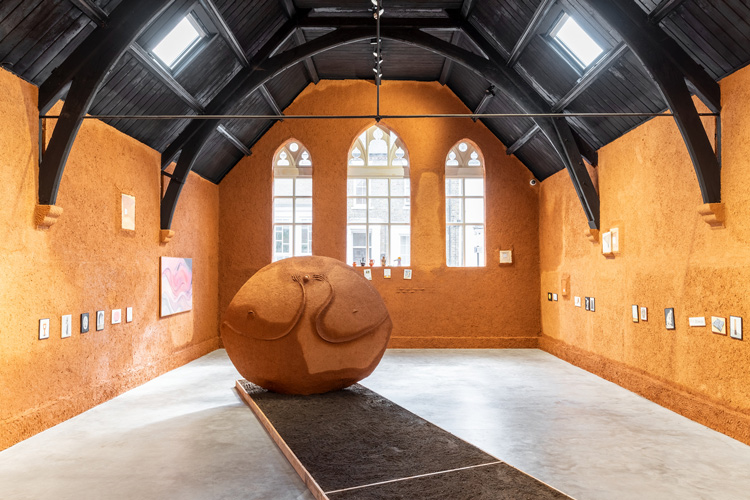
Gabriel Chaile in collaboration with Laura Ojeda Bär, Usos y costumbres, installation view, Studio Voltaire, 2023. Images courtesy of the artists and Studio Voltaire. Photo: Sarah Rainer.
Every wall, from the concrete floor up to the black-painted roof timbers, is covered in a thick adobe crust, through which the church windows are crisply outlined. Silhouetted by these windows, a large, elliptical adobe form is placed at the end of a long tray of loose, black earth. The walls are adorned with paintings: a slightly wonky, wacky selection, some small, others large, some protruding into the room from a raised adobe frame showing fictional views up to the clouds and the heavens. These are the work of Chaile’s long-time friend and collaborator Laura Ojeda Bär (b1986, Buenos Aires), whom he invited to join him in this residency.
Born and raised in San Miguel de Tucumán, Chaile’s environment was a rich mixture of Spanish, Afro-Arab and indigenous influences, but it is the pre-Colombian materials, forms, rituals and archetypal symbols that he likes to conjure in his pieces and installations, evoking the universal design language of food and farming – jugs, bowls and urns. His gift is to transform these vessels into characters with an eternal, anthropomorphic quality.
As well as at the 2022 Venice Biennale, Chaile’s work has been exhibited at the 2021 New Museum Triennial, New York); Fondation Thalie, Brussels (2021); the Museum of Modern Art of Buenos Aires (2017); Centro Cultural San Pablo T, Tucumán (2016); Centro Cultural Recoleta, Buenos Aires (2015); and the National Arts Fund, Buenos Aires (2014). He has just completed a commission by New York’s High Line, creating an outsized adobe vessel, called The Wind Blows Where It Wishes, which will stay in place until April 2024.
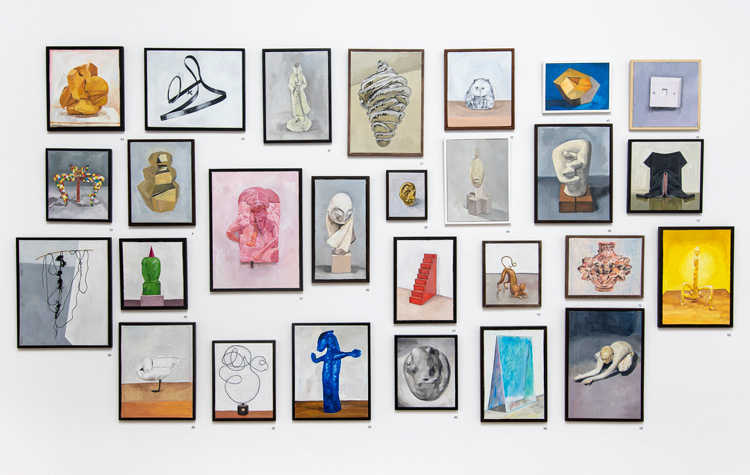
Laura Ojeda Bär, Decolonial Gift Shop, installation view, Moria
Galeria Argentina, 2022. Courtesy of the Artist.
Ojeda Bär is an artist and curator, living and working in Buenos Aires. Her work questions the prevailing power dynamics, especially in relation to perceived hierarchies in art history, and the interplay between public and personal values. In 2019, she took part in the Nes artist residency in Iceland and the Universidad Torcuato di Tella Artists’ Programme in Argentina. In 2020, she was commissioned by the Inter-American Development Bank to produce new work for its Washington headquarters. Ojeda Bär’s works are held in private and public collections in Argentina, Mexico, Portugal, Brazil and the US. In 2022, her works were shown in Buenos Aires at the Colección de Arte Amalia Lacroze de Fortabat, the Casa Nacional de Bicentenario, the Centro Cultural Recoleta and the Moria Gallery; in 2021, she showed at the Casa Argentina in Rome; and in 2019 at the Fundación Tres Pinos, Buenos Aires.
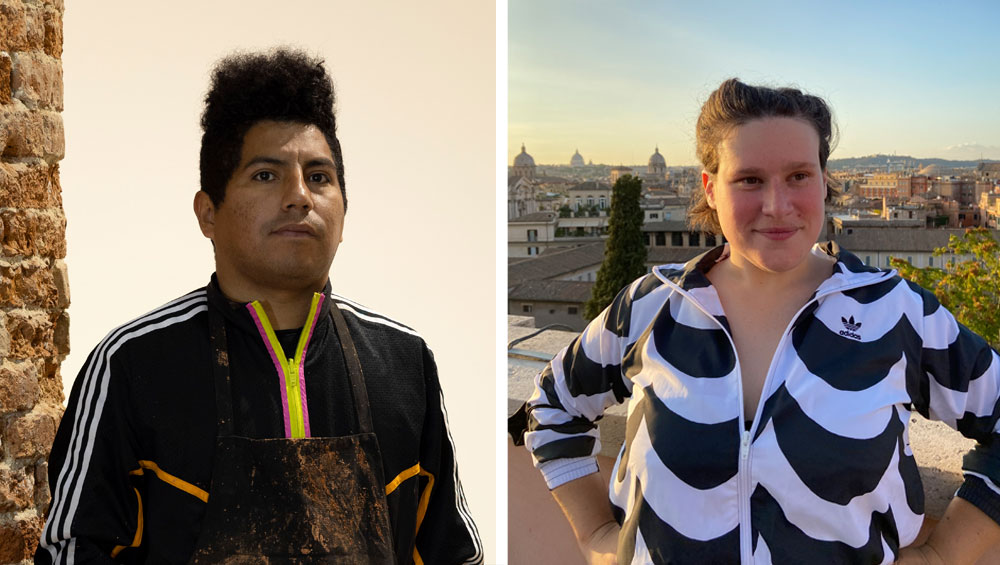
Gabriel Chaile, photo Andrea Rossetti (left) and Laura Ojeda Bär, photo Matias Ercole.
Studio spoke with both artists at Studio Voltaire.
Veronica Simpson: Have you worked together before?
Laura Ojeda Bär: No. We are really good friends from Buenos Aires, and we have known each other for 12 years. We shared this very formative stage as artists. Since then, we’ve always been very talkative about art and what we’re doing, but we had never shown together. Last December, Gabriel came back to Buenos Aires and said he was working at this place in London, and that we should do something in the gallery, a dialogue with the institution.
Gabriel Chaile: I said: “I know it’s a solo show, but I want to invite someone else and rethink the link between what an individual work is and what a collective work is. Maybe it’s not so defined.”
VS: Had either of you seen this space before?
GC: Yes, I had. I came for Frieze in 2022. But everything was painted black because it was hosting a video projection, so I didn’t really have a sense of the space, the size. Also, the windows were covered up. But I sensed the general shape. Then we were sent pictures and I was very taken by the light that comes through the windows. That’s when I thought about Laura, because she has a series of paintings about light, and windows in particular. What I first thought about was a dialogue between those paintings and something of mine. But I didn’t have a clear visual idea, it was an idea of having a dialogue.
VS: When did you get the idea of covering all the walls in adobe?
LOB: Maybe two months ago, we were talking on Zoom, and two hours later Gabriel sent me a WhatsApp and said: “I’m thinking about this that I’ve always wanted to do.” He sent me a picture of a church in the north-west of Argentina. There is this place called the Ruta del Adobe (Route of the Adobe). It’s a very dry place and they build houses and chapels with this kind of material. It’s a very easy material to build with, almost like Plasticine: you build it up by hand and so it’s very easy to fix as well. If it cracks, you just put on more material.
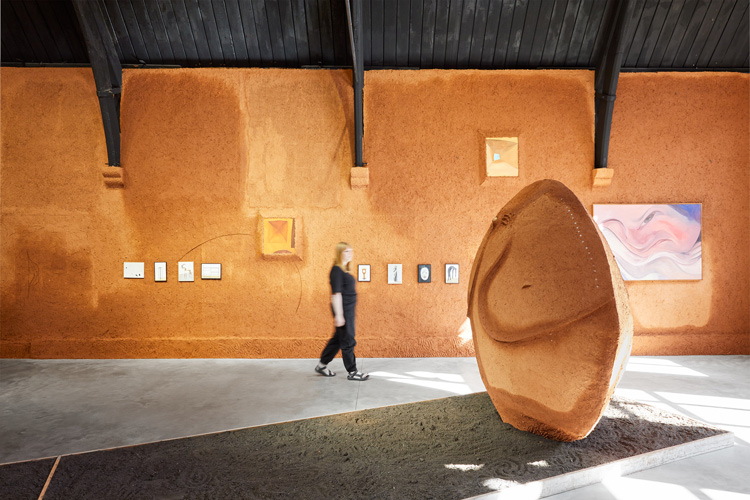
Gabriel Chaile in collaboration with Laura Ojeda Bär, Usos y costumbres, installation view, Studio Voltaire, 2023. Images courtesy of the artists and Studio Voltaire. Photo: Sarah Rainer.
VS: Gabriel, this is the material you usually work with, but never on this scale? Where is the clay from?
GC: It’s from Portugal. I asked for London clay, and they couldn’t access this amount - it’s a lot, about two tonnes of clay, and two tonnes of metal underwire all over the chapel.
VS: Perhaps, first, you could take us through the practicalities of how your work is constructed, how you make these big, beautiful adobe shapes and forms.
GC: I am not a ceramicist. I studied sculpture, and this material looks like ceramic, but it’s not. The adobe is a mixture of clay, sawdust and water and it is applied to a metal structure. It doesn’t need to be fired; it just dries out. It goes from something very pliable to something very hard. I draw my sculptures and someone makes the technical drawings and then a blacksmith makes the structure, like a mesh, and then, within that mesh, we put on the adobe.
VS: This work in the chapel is like a continuation of that practice of applying the adobe to a metal structure.
GC: The process is exactly the same, but the big difference is that those are objects that occupy a space, but this is creating a space. It’s very different and very handmade – artisanal – because it’s like architecture in size, but then it’s made like something smaller.
VS: What were the problems of applying that method to a whole building interior?
GC: It was a real challenge from the production point of view, but also physically. It was so much work. But also, because of that, I’m really happy to be able to do this. Because when we started talking [about the project] I was in New York doing a classical sculpture on the High Line - a big, bulky sculpture. At first, the idea was to continue that line of work, almost exactly, following the same steps. But then Studio Voltaire really allowed us to experiment a lot more, to explore a lot of things that I’ve been thinking about and wanted to try, but I have never in these last years had the space to do something a bit different. I’m very happy with it.
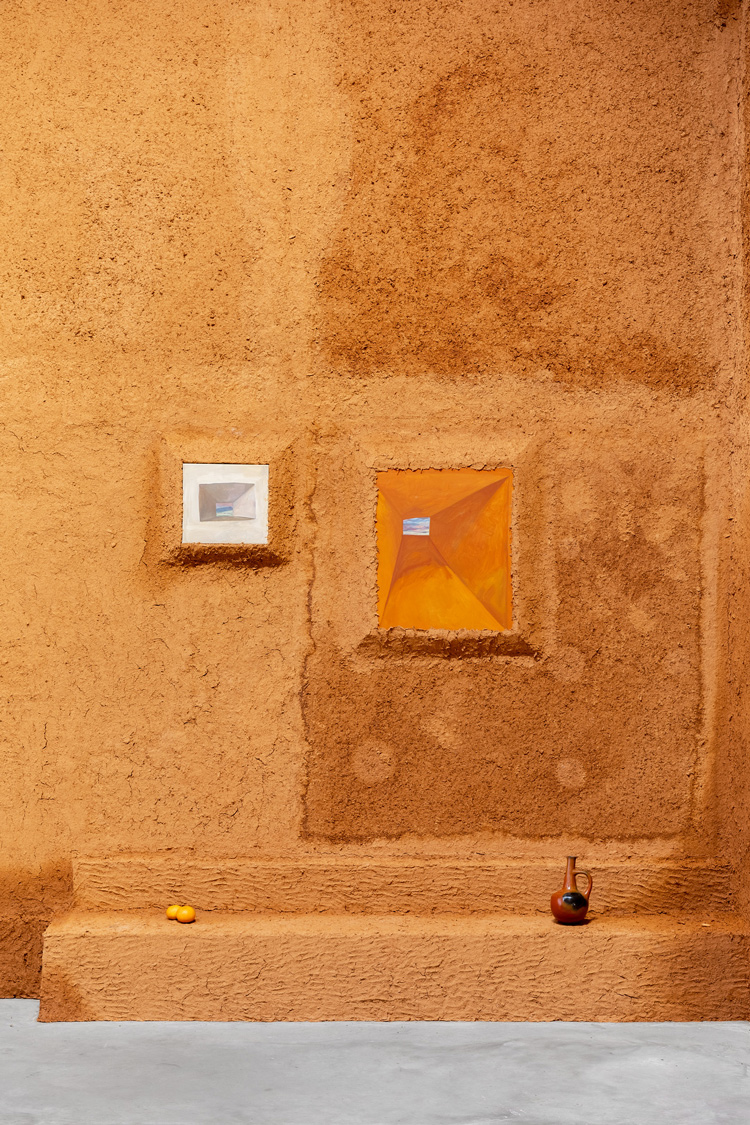
Gabriel Chaile in collaboration with Laura Ojeda Bär, Usos y costumbres, installation view, Studio Voltaire, 2023. Images courtesy of the artists and Studio Voltaire. Photo: Sarah Rainer.
VS: This is what a residency should be – a chance to advance your practice, to experiment.
GC: Yes. It seems to be the most ambitious project I’ve done in a while, and I’ve done some very big ones. This was very different. The other projects I’ve been doing are very interesting, but also very individual.
VS: Did it inspire any new ideas and thoughts while you were doing it, because the physical experience of this making is so different from your usual practice?
GC: Yes, here it was much more intense. Usually, my sculpture has an animated or anthropomorphic quality, and this reminds me more of my oven pieces. It’s functional. It has a practical use. I have been thinking for a long time about doing something more architectural and I didn’t know what, and then this opportunity came.
VS: What were you thinking you would like to do on an architectural level?
GC: During the pandemic in 2020, in self-isolation, I had lots of time like everyone else, and I used to draw the perfect house for my family, and my mother. I wanted to build it in adobe and then I never did. It’s something that’s been in my head.
VS: You are known for liking to work in collaboration, but this must have been far more physically collaborative - not just making the work together with Laura, but plastering the building with adobe. You had help, I think.
GC: Yes, this is the first time that the collaborative work is really visible.
LOB: We founded an artist collaborative, NVS, based in Lisbon, and it really is a mutating entity. Sometimes, it’s a commercial gallery, sometimes it’s an event with food and music, and sometimes it’s a publishing house. It doesn’t have a strict form, it’s just people coming together and doing stuff like we do alone and having excuses to meet. Because I live in Buenos Aires and Gabriel is always travelling, having this opportunity has been amazing, not just because of the show, but being in the same place at the same time, to be here together for three or four weeks and reconnect and explore the collaborative aspect of all of our work.
GC: Also, the guys who came from Lisbon to help me here, but who also help me in different projects and sculptures, they are like the living matter of NVS. They work together, and I am leading a project, but then we do something else, and we grow and change. It’s the first project that makes visible the collaborative aspect of NVS. And the process of making such a time-consuming work means we talk about a lot of things while we’re working and putting on the mud. There were lots of conversations going on.
Voltaire’s invitation to do the show turned out to be this amazing opportunity for lots of us coming together. There were people who came from Rome and the Philippines and Buenos Aires and Lisbon, for the opening, and then people who live in London. Because of the exhibition, we were able to gather everyone here for four or five days and it’s been really great, to discuss what we want to do.
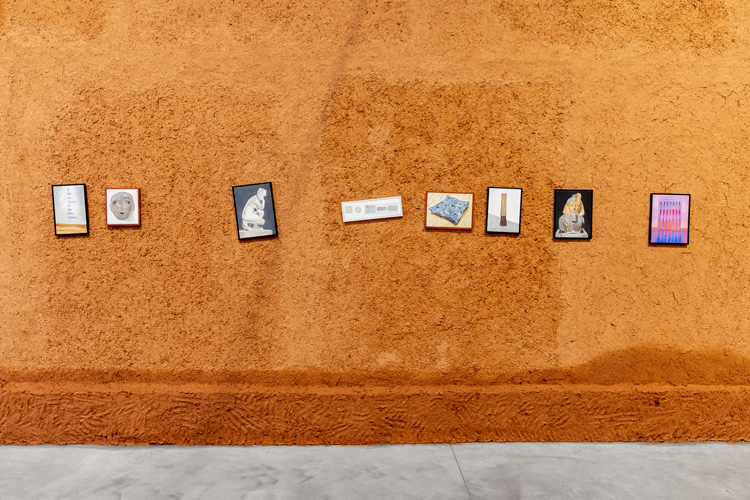
Gabriel Chaile in collaboration with Laura Ojeda Bär, Usos y costumbres, installation view, Studio Voltaire, 2023. Images courtesy of the artists and Studio Voltaire. Photo: Sarah Rainer.
VS: I am intrigued to know what it was like to work on such large, flat planes, given that your structures are usually very curving and feel like an extension of the body. Did that challenge you?
GC: Normally, I use curves because I don’t like straight lines. It was very different here because it’s not so much the creation of a shape as an imitation of the form underneath. Getting to know the space through copying it, you really feel the size and the height. Also, you make visible the different histories and narratives that come together, because it’s like a white cube but also like a chapel. There are so many stories, histories and different times that come together within this gallery. It’s like when you have an object and you touch it so many times that you know that object through touch not just through your eyes. It’s a different way of understanding what it is. It changes the way you feel in a space.
VS: Tell me about this lovely curvaceous sculpture in the middle of the space.
LOB: I call the sculpture the big lentil, because it’s like a big lentil. But, actually, it’s called Laura, it’s a portrait of me. And this [she gestures to a painting beside it] is my portrait of Gabriel. It’s like a very big homage to each other. Because I make lots of self-portraits and portraits and he does, too, that’s something we have in common. I did this while I was here waiting for him to come from Lisbon: I painted him and hung him here in the gallery.
VS: And, Laura, what about the response of your work to this space? Many of these paintings are of masterpieces in national museums in the UK. Did you make all this work during the residency?
LOB: I was born and brought up in Buenos Aires and all my art education came from reproductions and pictures and the internet and my mobile phone, so the artworks that shaped my point of view and my tastes were always very far away. I love sculpture and yet I’ve never seen most of my favourite sculptures. I painted 44 of these small paintings [from books and images on the internet] and carried them in my luggage. They are very travel friendly in that they are very tiny. They are all from pieces in the collections of London museums, the British Museum and Tate. They are in this city in body. But now they are here too.
I am really interested in the link we can have with artworks through distance. I want to show that there is a sense of longing, but also connection: you do not need to be in front of an object to have a relationship with it.
That was the first dialogue and then we got here and started to talk and think in the same way. We started thinking it would be great to have more windows, wanting to make the space warmer and more inviting. Windows for us are always sunny, an invitation. Here, it’s more about being in a place where you’re guarded against nature, but you can peek outside. But we cannot just break the walls. So, I said we cannot do windows, but I can paint some. A dialogue of what do we want and how do we make that happen. I call them windows. Being able to make things happen through art, we really believe that art is not just a job, but also like an attitude towards life. How can we make this happen?
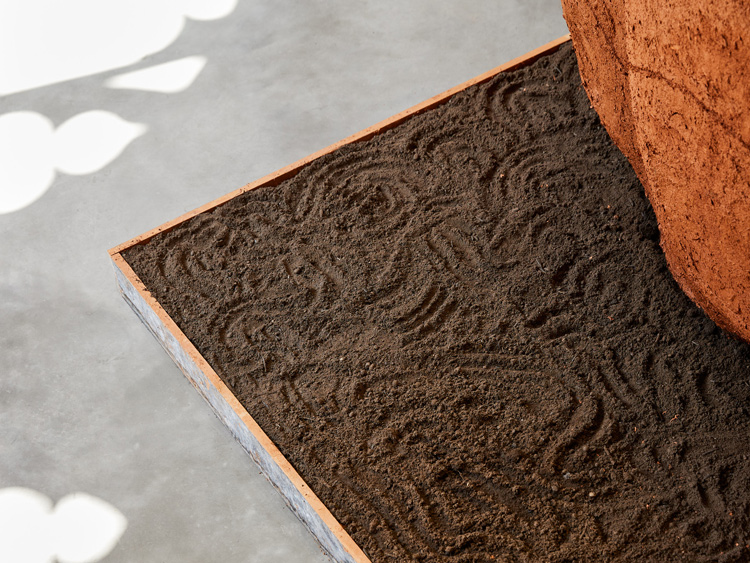
Gabriel Chaile in collaboration with Laura Ojeda Bär, Usos y costumbres, installation view, Studio Voltaire, 2023. Images courtesy of the artists and Studio Voltaire. Photo: Sarah Rainer.
VS: Gabriel, can you tell me why this big sculpture, Laura, is sitting in a long tray of earth?
GC: I used to do this kind of base in my earlier work, with soil. For me, my sculptures are kind of like flowerpots. Also, they have this red, terracotta colour. But I normally do square trays, bound around the sculpture, and this time I did this long tray, to be able to put this movement, by hand, in the trays: it’s a kind of watery movement, the ripples, and it’s also the movement of the hand.
VS: I can see across the walls there is also some sculpting and shaping and movement. It is a really transporting quality that you have created here – the rich colours and that smell of mud and sawdust, and the light you have captured in the windows, Laura – it takes you to a whole different place.
GC: We’re really into that: the power of art to transform and transmute places and objects and people, and we really like cartoons, and how sometimes the fiction and the lines are so intense, almost hallucinatory.
The adobe house is very common in rural areas, deep Argentina. If you go to Buenos Aires, you don’t have any adobe anywhere, but if you go away from the big cities, it’s a very usual way of construction. But someone came from India and said he was reminded of antique ways of building in India too.
It’s like in ceramics – there is this kind of universal technology and different people from very different parts of the world end up creating things that are very close in shape. Those ceramics [he points to the vessels lined up on a windowsill] are from different parts of the world. There is an Ethiopian coffee pot that I bought here, in Brixton, and then the brightest one is from Argentina, from people who live very near the whole Adobe Route. The next is Portuguese, and the next one is also Ethiopian. And the last one is Mexican, which I bought in New York. There are many migrations. Shapes travel with their people.
VS: You are bringing other parts of the world, but also ancient practices that are indigenous, into this space, a kind of migratory cultural cross-pollination.
GC: Sometimes it seems as if institutions have a certain programme and what they want and what they need is just to keep duplicating certain shapes and materials. It’s not really in their plan to allow, or to encourage experimentation. That’s why, for me, this institution, Voltaire, is so helpful: its trust that I can do something different and giving us the space to do that.
• Gabriel Chaile in Collaboration with Laura Ojeda Bär: Usos y Costumbres is at Studio Voltaire, London, until 10 September 2023.